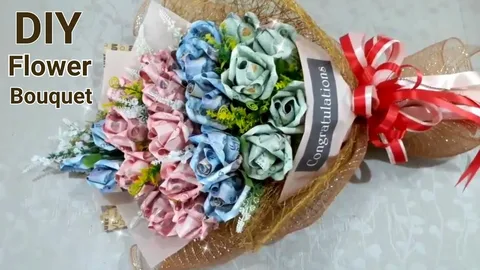Table of Contents
Wrapping a flower bouquet is not just about presentation; it protects delicate stems, enhances the beauty of the arrangement, and makes the gift look polished. The simplest method involves arranging flowers, trimming stems evenly, placing them on wrapping paper or tissue, and folding the paper around them securely with tape or ribbon.
This guide explains step by step how to wrap bouquets like a professional, compares wrapping styles, shares material options, and answers common questions.
Materials You’ll Need
Before starting, gather these essentials:
- Fresh flowers (trimmed and arranged)
- Wrapping paper, kraft paper, or tissue
- Scissors
- Clear tape or floral tape
- Ribbon, twine, or string
- Optional: Cellophane, fabric wrap, or decorative mesh
Step-by-Step Guide: Wrapping a Bouquet
1. Prepare the Flowers
- Remove leaves below the binding point.
- Trim stems at an angle for better water absorption.
- Group flowers in your hand, starting with focal blooms in the center.
2. Position on Wrapping Paper
- Place the bouquet diagonally on wrapping paper.
- Leave extra paper at the top for coverage.
- Fold the bottom corner over the stems.
3. Fold and Secure
- Wrap one side of the paper across the flowers.
- Overlap with the other side for a cone-like shape.
- Secure with tape, then tie ribbon or twine around stems.
4. Add Finishing Touches
- Fluff the paper edges for volume.
- Add a bow or decorative charm.
- Mist lightly with water if transporting.

Comparison of Wrapping Styles
| Wrapping Style | Best For | Look/Finish | Difficulty |
| Kraft Paper Wrap | Rustic, eco-friendly gifts | Natural & minimal | Easy |
| Cellophane Wrap | Formal events, weddings | Glossy, elegant | Medium |
| Fabric Wrap | Sustainable gifting | Soft, luxurious | Medium |
| Cone Wrap | Single-bloom bouquets | Modern & chic | Easy |
| Double-Layer Wrap | Mixed flower bouquets | Professional, full | Harder |
Technical Data: Wrapping Paper Options
| Material | Thickness (gsm) | Pros | Cons |
| Kraft Paper | 70–90 | Eco-friendly, sturdy | Limited color variety |
| Tissue Paper | 17–30 | Lightweight, colorful | Tears easily |
| Cellophane | 20–40 microns | Waterproof, glossy finish | Non-biodegradable |
| Fabric (Cotton) | 150–200 | Reusable, premium feel | Higher cost |
| Decorative Mesh | 80–120 | Stylish, breathable | Less protective |
Things to Consider Before Wrapping
- Flower freshness: Wrapping won’t fix wilted flowers.
- Occasion: Choose wrap style to match (formal, casual, eco-friendly).
- Durability: Cellophane protects against moisture, while paper adds rustic charm.
- Transport time: If flowers travel long, use damp tissue inside wrap to keep stems moist.
Common Questions About Wrapping Bouquets
Why do florists wrap bouquets?
Wrapping protects delicate stems, prevents flowers from shifting, and enhances presentation.
How long do flowers last after being wrapped?
On average, 1–2 days without water. Add damp tissue inside for longer freshness.
Can I reuse wrapping materials?
Yes, fabric and ribbons are reusable. Paper can be composted or recycled.
Is cellophane wrapping eco-friendly?
Traditional cellophane is plastic-based, but biodegradable options are available.
Bonus Tips
Use two contrasting paper layers for a premium look.
Wrap stems in wet cotton or tissue inside foil if gifting without a vase.
For large bouquets, tie stems first with floral tape before wrapping for stability.
FAQ
Q1. How do I wrap a bouquet without tape?
Use ribbon, twine, or even a fabric knot for a secure eco-friendly finish.
Q2. Should flowers be wrapped wet or dry?
Stems should be dry outside but can be wrapped with damp tissue inside for freshness.
Q3. What’s the easiest bouquet wrap for beginners?
A simple kraft paper cone wrap is easiest and stylish.
Q4. How do florists make wraps look fluffy?
By folding extra paper outward at the top to create volume.
Q5. Can I mix materials like paper and fabric?
Yes, mixing adds texture and visual depth, often seen in luxury bouquets.
Conclusion
Wrapping a flower bouquet is simple once you know the basics. From rustic kraft paper to elegant cellophane or fabric wraps, the right choice depends on the occasion, durability needs, and personal style. By preparing flowers carefully and choosing suitable wrapping materials, you can create a gift that feels thoughtful and looks professional.
